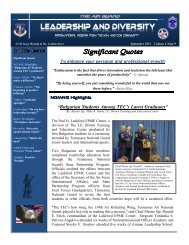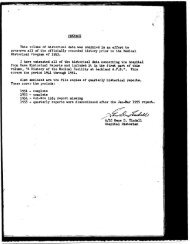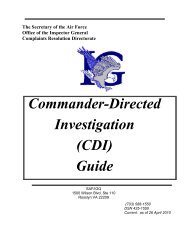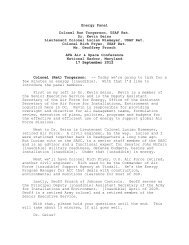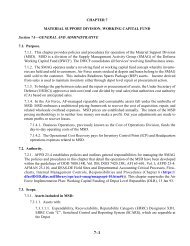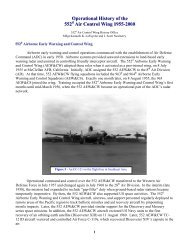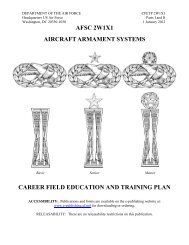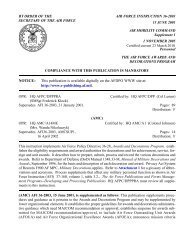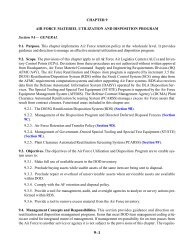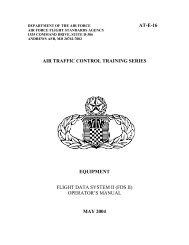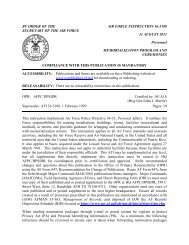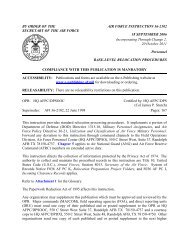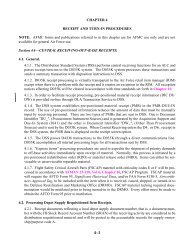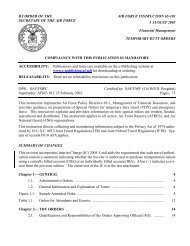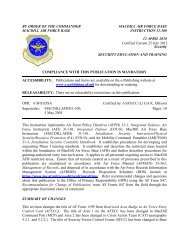CONTRAILS FACTS - Air Force Link
CONTRAILS FACTS - Air Force Link
CONTRAILS FACTS - Air Force Link
- TAGS
- contrails
- link
- www.af.mil
You also want an ePaper? Increase the reach of your titles
YUMPU automatically turns print PDFs into web optimized ePapers that Google loves.
Appleman, H., 1953. The formation of exhaust condensation trails by jet aircraft. Bulletin of the<br />
American Meteorological Society 34: 14-20. Brewer, A.W., 1946. Condensation trails. Weather<br />
1: 34-40.<br />
Chipley, Michael Ph.D. A Review Of Military Aviation And Space Issues, The Forum For<br />
Environmental Law, Science, Engineering And Finance, December 1999.<br />
Chipley, Michael Ph.D. A Review Of Military Aviation And Space Issues: Aerospace And<br />
<strong>Air</strong>space" (Part II), The Forum For Environmental Law, Science, Engineering And Finance,<br />
January 2000.<br />
Spargo, B.J., Environmental Effects of RF Chaff, Naval Research Laboratory, Washington,<br />
D.C., August 31, 1999.<br />
Pike, John, <strong>Air</strong>craft Weapon Loads, Federation of American Scientists, 2000.<br />
<strong>Air</strong>craft and Contrails. EPA publication number EPA430-F-00-005. 6 pp EPA, 2000.<br />
(www.epa.gov/otaq/aviation.htm)<br />
Layman's Library<br />
Contrails - Contrails, or condensation trails, are "streaks of condensed water vapor created in<br />
the air by an airplane or rocket at high altitudes."(Webster's Dictionary). Contrails are the result<br />
of normal emissions of water vapor from jet engines. At high altitudes, water vapor condenses<br />
and turns into a visible cloud. Contrails form when hot humid air from jet engines mixes with the<br />
surrounding air in the atmosphere which is drier and colder. The mixing is a result of turbulence<br />
generated by the jet engine exhaust. The water vapor in the jet exhaust then condenses and<br />
forms a cloud. The rate at which contrails dissipate is entirely dependent upon weather<br />
conditions and altitude. If the atmosphere is near saturation, the contrail may exist for some<br />
time. Conversely, if the atmosphere is dry, the contrail will dissipate quickly.<br />
Contrail Grid Patterns - Numerous contrails are usually over "air routes", or highways in the<br />
sky. <strong>Air</strong>craft fly in all different directions at any time, and numerous contrails may seem to<br />
"crisscross". Although contrails may appear to cross, the trails can actually be from planes<br />
separated by significant altitude and time.<br />
Chaff - Chaff are small bundles of aluminum coated fibers that create a large radar reflection. A<br />
radar seeking missile is unable to distinguish an aircraft from the chaff and loses the lock on the<br />
aircraft.<br />
Chemtrails - Chemtrails is a term coined to suggest contrails are formed by something other<br />
than a natural process of engine exhaust hitting the cold air in the atmosphere.<br />
Ethylene dibromide - Ethylene dibromide, or EDB, is a pesticide that was used commercially<br />
before being banned by the Environmental Protection Agency in 1983. During WW II, EDB was<br />
used as an additive in aviation gasoline to help stop lead in the aviation gasoline from plating<br />
out on valves. Jet fuels, including JP-8 have never contained EDB. Soil samples showing the<br />
presence of EDB are most likely residuals from previous use as a pesticide. Webster's<br />
dictionary definition of EDB: ": a colorless toxic liquid compound C2H4Br2 that is used chiefly as<br />
a fuel additive in leaded gasolines, that has been found to be strongly carcinogenic in laboratory



